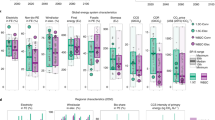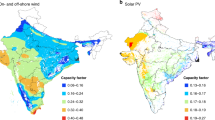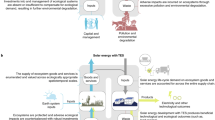Abstract
Integrating solar thermal systems into Rankine-cycle power plants can be done with minimal modification to the existing infrastructure. This presents an opportunity to introduce these technologies into the commercial space incrementally, to allow engineers to build familiarity with the systems before phasing out fossil-fuel energy with solar electricity. This paper shows that there is no thermodynamic barrier to injecting solar thermal heat into Rankine-cycle plants to offset even up to 50% fossil-fuel combustion with existing technology: with better solar-to-electricity efficiencies than conventionally deployed solar-thermal power plants. This strategy is economically preferable to installing carbon-capture and compression equipment for mitigating an equivalent amount of greenhouse-gas emissions. We suggest that such projects be encouraged by extending the same subsidy/incentives to the solar-thermal fraction of a ‘solar-aided’ plant that would be offered to a conventionally deployed solar-thermal power plant of similar capacity. Such a policy would prepare the ground for an incremental solar-thermal takeover of fossil-fuel power plants.
This is a preview of subscription content, access via your institution
Access options
Subscribe to this journal
Receive 12 print issues and online access
$209.00 per year
only $17.42 per issue
Buy this article
- Purchase on Springer Link
- Instant access to full article PDF
Prices may be subject to local taxes which are calculated during checkout


Similar content being viewed by others
References
Renewable Energy Now Cheaper than New Fossil Fuels in Australia. Bloomberg New Energy Finance (7 Feburary 2013); http://about.bnef.com/press-releases/renewable-energy-now-cheaper-than-new-fossil-fuels-in-australia
Carr, G. Sunny uplands. The Economist (21 November 2012); http://www.economist.com/news/21566414-alternative-energy-will-no-longer-be-alternative-sunny-uplands
Germany’s Tenuous Transition to Renewable Energy (Stratfor, 2013); http://www.stratfor.com/sample/analysis/germanys-tenuous-transition-renewable-energy
Gabriel: Beim Klimaschutz ist das Ziel nicht zu halten (Spiegel Online, 2014); http://www.spiegel.de/politik/deutschland/gabriel-beim-klimaschutz-ist-das-ziel-nicht-zu-halten-a-1003183.html
Hansen, J. E. Storms of My Grandchildren: The Truth About the Coming Climate Catastrophe and our Last Chance to Save Humanity (Bloomsbury, 2009).
Parry, I., Veung, C. & Heine, D. How Much Carbon Pricing is in Countries’ Own Interests? The Critical Role of Co-Benefits (International Monetary Fund, 2014); http://papers.ssrn.com/sol3/papers.cfm?abstract_id=2512804
Bawden, T. New era of cheap oil ‘will destroy green revolution’. The Independent (12 December 2014); http://www.independent.co.uk/environment/new-era-of-cheap-oil-will-destroy-green-revolution-9922217.html
Options and Considerations for a Federal Carbon Tax (Centre for Climate and Energy Solutions, 2013); http://www.c2es.org/publications/options-considerations-federal-carbon-tax
Shah, A. Climate Justice and Equity (Global Issues, 2011); http://www.globalissues.org/article/231/climate-justice-and-equity
Hoffert, M. I. Farewell to fossil fuels? Science 329, 1292–1294 (2010).
Koningstein, R. & Fork, D. What it would really take to reverse climate change. IEEE Spectr. 30–35 (2014); http://spectrum.ieee.org/energy/renewables/what-it-would-really-take-to-reverse-climate-change
Pfenninger, S. et al. Potential for concentrating solar power to provide baseload and dispatchable power. Nature Clim. Change 4, 689–692 (2014).
Philibert, C. et al. Technology Roadmap (International Energy Agency, 2010); http://www.iea.org/publications/freepublications/publication/csp_roadmap.pdf
Sinden, G. Characteristics of the UK wind resource: Long-term patterns and relationship to electricity demand. Energy Policy 35, 112–127 (2007).
CSP Projects Around the World (SolarPACES Organization, 2015); http://www.solarpaces.org/csp-technology/csp-projects-around-the-world
How Solar PV is Winning Over CSP (Renewable Energy World, 2014); http://www.renewableenergyworld.com/rea/blog/post/2013/03/how-solar-pv-is-winning-over-csp
Reuters Solar Thermal Plants Scrap Steam for Photovoltaic (CNET, 2011); http://www.cnet.com/news/solar-thermal-plants-scrap-steam-for-photovoltaic
Petrov, M. P., Salomon Popa, M. & Fransson, T. H. World Renewable Energy Forum, WREF 2012, Including World Renewable Energy Congress XII and Colorado Renewable Energy Society (CRES) Annual Conference 2682–2689 (American Solar Energy Society, 2012); http://www.diva-portal.org/smash/record.jsf?pid=diva2:600916
Siros, F., Le Moullec, P. Y., Tussea, M. & Bonnelle, D. in Proc. SolarPACES (SolarPACES, 2012).
Pacala, S. & Socolow, R. Stabilization wedges: Solving the climate problem for the next 50 years with current technologies. Science 305, 968–972 (2004).
Shinnar, R. & Citro, F. A road map to U.S. decarbonization. Science 313, 1243–1244 (2006).
Turchi, C. S., Langle, N., Bedilion, R. & Libby, C. Solar-Augment Potential of US Fossil-Fired Power Plants (National Renewable Energy Laboratory, 2011); http://www.nrel.gov/docs/fy11osti/50597.pdf
Sukhatme, S. P. & Nayak, J. K. Solar Energy: Principles of Thermal Collection and Storage (Tata McGraw-Hill, 2008).
Pierce, W., Gauché, P., von Backström, T., Brent, A. C. & Tadros, A. A comparison of solar aided power generation (SAPG) and stand-alone concentrating solar power (CSP): A South African case study. Appl. Therm. Eng. 61, 657–662 (2013).
Suresh, M. V. J. J., Reddy, K. S. & Kolar, A. K. 4-E (Energy, Exergy, Environment, and Economic) analysis of solar thermal aided coal-fired power plants. Energy Sustain. Dev. 14, 267–279 (2010).
Gupta, M. K. & Kaushik, S. C. Exergetic utilization of solar energy for feed water preheating in a conventional thermal power plant. Int. J. Energy Res. 33, 593–604 (2009).
Rubin, E., Meyer, L. & de Coninck, H. IPCC Special Report on Carbon Dioxide Capture and Storage: Technical Summary (Cambridge Univ. Press, 2005); http://www.ipcc.ch/pdf/special-reports/srccs/srccs_technicalsummary.pdf
Ghosh, A. et al. Concentrated Solar Power: Heating Up India’s Solar Thermal Market Under National Solar Mission (Council on Energy, Environment and Water, and Natural Resources Defense Council, 2012); http://ceew.in/pdf/CEEW-NRDC-Concentrated%20Solar%20Power_Sep12.pdf
Byrnes, L., Brown, C., Foster, J. & Wagner, L. D. Australian renewable energy policy: Barriers and challenges. Renew. Energy 60, 711–721 (2013).
Zhai, R., Yang, Y., Zhu, Y. & Chen, D. The evaluation of solar contribution in solar aided coal-fired power plant. Int. J. Photoenergy 2013, e197913 (2013).
Acknowledgements
We are grateful to the Institute of Chemical Technology, Mumbai and the Homi Bhabha National Institute, Mumbai for their support.
Author information
Authors and Affiliations
Contributions
All authors contributed equally to the article.
Corresponding author
Ethics declarations
Competing interests
The authors declare no competing financial interests.
Supplementary information
Rights and permissions
About this article
Cite this article
Dalvi, V., Panse, S. & Joshi, J. Solar thermal technologies as a bridge from fossil fuels to renewables. Nature Clim Change 5, 1007–1013 (2015). https://doi.org/10.1038/nclimate2717
Received:
Accepted:
Published:
Issue Date:
DOI: https://doi.org/10.1038/nclimate2717
This article is cited by
-
Plant-leaf-inspired MXene-silk composite for intelligent solar steam generation combined with mechanical actuation
Nano Research (2023)
-
Interfacial Solar Evaporator - Physical Principles and Fabrication Methods
International Journal of Precision Engineering and Manufacturing-Green Technology (2021)
-
Integration of mechanical deformation and optical losses in the design of linear Fresnel solar collectors
International Journal on Interactive Design and Manufacturing (IJIDeM) (2019)
-
Carbon nanocomposites with high photothermal conversion efficiency
Science China Materials (2018)
-
Dynamic tuning of optical absorbers for accelerated solar-thermal energy storage
Nature Communications (2017)



